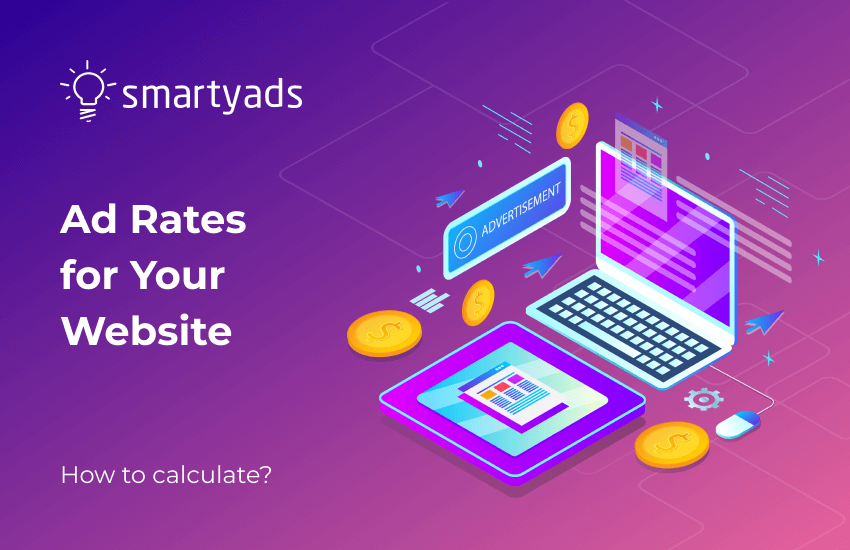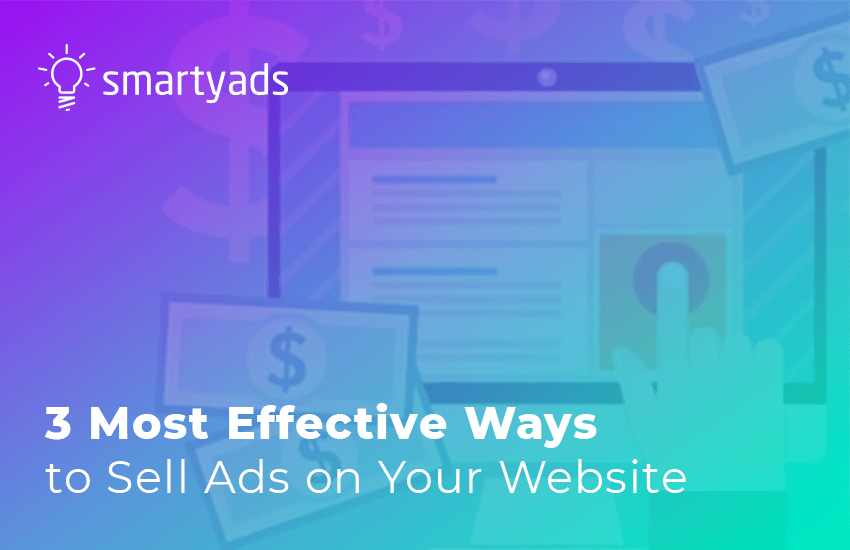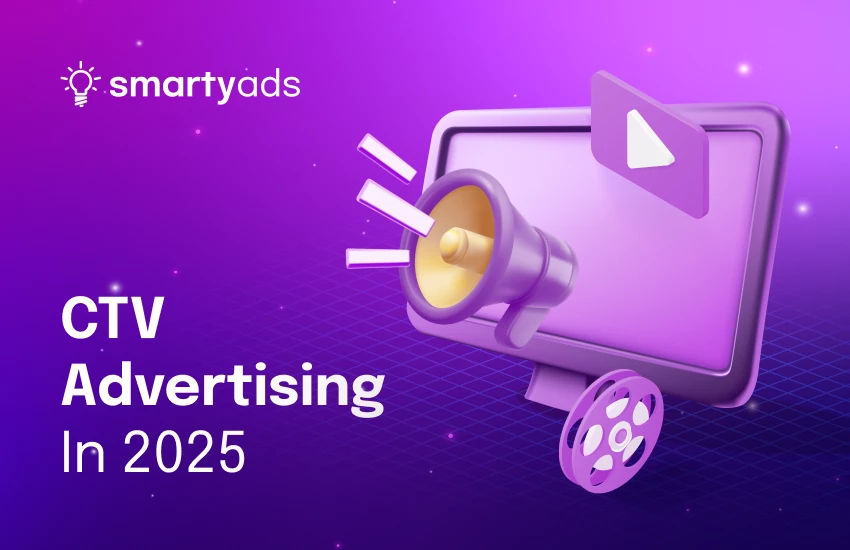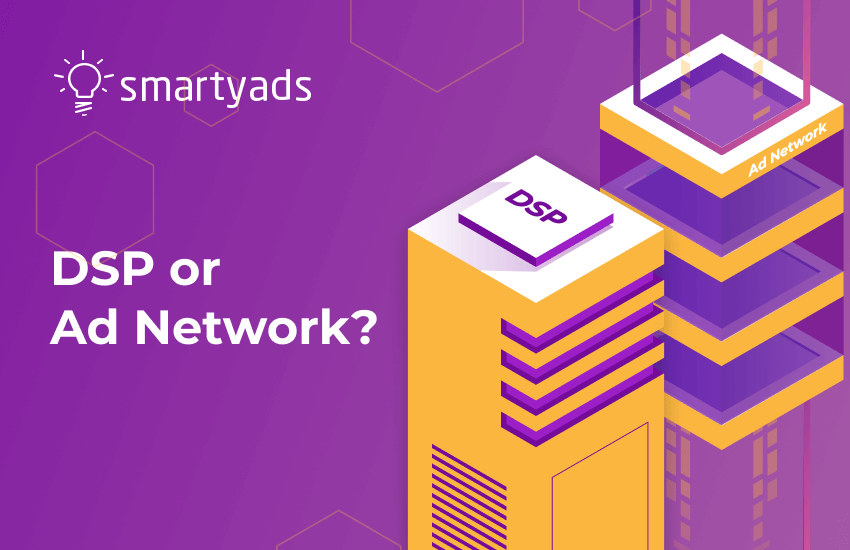Publishers often find themselves wondering how to monetize website traffic or how much to charge for ads. The reality is that online advertising can differ greatly depending on the niche, affecting demand, profits, ad rates, and the effectiveness of various strategies.
In 2024, average CPM (cost-per-thousand-impressions) for display ads is between $2 and $5, while video ads can range from $10 to $25, influenced by the platform and audience. Additionally, CTV ad spend exceeded $20B for the first time in 2023 and is projected to grow 12% in 2024 — 32% faster than total media overall.
To stay competitive, publishers need tailored strategies for each platform. For example, CTV providers are utilizing programmatic ads, while music-streaming services focus on dynamic ad insertion for a more personalized touch. Understanding these market trends is vital for developing the right pricing model and maximizing revenue. Let’s dive into the key factors that influence online ad costs and how to establish an effective pricing strategy for advertisers.
Key Takeaways:
- Online advertising rates vary greatly depending on factors like traffic, content quality, audience demographics, and ad format. Publishers can earn anywhere from $0.01 per click to $450,000 daily for major platforms.
- Factors like Geo, audience interests, and engagement heavily influence ad costs. Sites with high traffic and targeted audiences can charge more, especially in premium niches like finance and real estate.
- CPM (Cost per Mille) and CPC (Cost per Click) are common pricing models. CPM works well for larger publishers, while CPC suits smaller publishers with high engagement.
- SmartyAds SSP offers a programmatic solution for publishers to connect with global advertisers and sell ad space through real-time bidding. It also allows for efficient ad pricing and performance tracking with detailed analytics.
- To set the right ad rates, consider your website metrics, industry benchmarks, and audience behavior. Testing different formats and pricing models will help optimize revenue.

What determines the cost of online advertising?
The industry has continued to grow since the dawn of digital advertising evolution and the introduction of web advertising. According to Grand View Research, the global data monetization market is expected to grow by a 24.1% compound annual growth rate between 2020 and 2027, which is valued at over $1.3 billion.
These numbers are truly impressive, but your audience data isn’t the only factor influencing your revenues. In fact, there are numerous characteristics a digital publisher should consider to determine their best-suitable website rates. Let us start with the numbers on the supply side that can help to determine how much to charge for ads on the website.
One should know that there are several significant features, unique for each website that can greatly impact your web ad price. For instance, web banner advertising rates can vary from $0,01 to $10 per click, depending on many important factors like:
- Geo
- Type of traffic and amount of traffic
- Audience
First of all, it is important to remember that there are certain benchmarks or requirements for digital publishers to fulfill in order to start selling ad space on their web pages. These can vary from platform to platform, depending on the monetization solutions you’ve chosen, but the general rule is the more value your ad placements can potentially bring to the advertisers, the more they are willing to pay for it.
Major giants like Yahoo, YouTube, Facebook, and Instagram can charge from $100,000 to $450,000 daily and more for online advertising on their front page. These websites have millions of viewers and can potentially bring enormous profits to anyone placing their offers on these hot spots.
So, when it comes to calculating your potential ad costs, take the following factors into consideration.
Traffic
Visitors increase the visibility of online ads, leading to more leads for your business. Marketers often invest heavily in ads that yield great results. To assess your advertising rates, track daily and monthly traffic metrics, particularly focusing on the last 30 days for monthly data.
Different pages on your site generate varying revenue; for instance, a page with 3 ads yields 3 ad impressions per view. While more impressions can boost profits, excessive ads can harm user experience, reduce engagement, and slow down page load times.
Embrace ad platforms. Once you’ve reached a certain number of visitors per month, you can start monetizing your pages via Google Ads, affiliate marketing, or the supply-side platform (SSP).
The required number of visitors for monetization varies by niche and platform. Some marketers suggest having at least 250 unique daily visitors, while others recommend 2,000 monthly. For platforms like Google AdSense, a few hundred daily visitors may suffice, but focus on valuable content and compliance with policies. Amazon Associates and some platforms have no minimum traffic requirement, but many do. Always check publisher policies before proceeding. If traffic is low, prioritize growing your audience through strategies like link building, blogging, and guest posting to improve search engine rankings.
Content
How much does an online ad cost on web sources that have great content and domain rating? Display network platform usually provides $1 for one click; in the CPM advertising model, this is usually $3.12 per thousand served ad impressions. However, there are also premium web sources, aka exclusive inventory, where clicks and impression serving can cost more. Knowing this, owners of such resources normally opt for PMPs (private marketplaces) or direct deals with advertisers (which, by the way, are also available within average programmatic ad platforms like SSP).
Assess your content niche. Website rates vary based on content quality and relevance to your target audience. Regularly publishing valuable content, including blog posts, videos, and discussions, enhances user engagement. Unique, in-depth answers to specific questions can attract more traffic, especially in high-paying industries. Avoid restricted content categories, which can hinder monetization opportunities.
Consider the buyer's journey; understanding your audience's decision-making process can increase the value of your site to advertisers. Websites focused on product reviews and comparisons tend to convert well and achieve higher ad rates.
Audience
Data about your audience is a valuable asset (insights about interests, demographics, and behavior). Understanding factors like age, hobbies, and location helps advertisers improve their campaigns and product performance. The more information you can provide about potential ad viewers, the higher the ad prices you can expect.
Most marketers want to know exactly who they are targeting, so web advertising cost that they are willing to pay depends on available audience data. They want to know what kind of message this target audience persona is going to react to. If your audiences’ characteristics align with the advertisers’ typical client, you are likely to get a long-term partner with a higher ad rate.
Define digital characteristics such as income, purchase intent, and online shopping history to identify valuable users. Additionally, factors like age, gender, and marital status are crucial for targeted advertising.
Consider the geographical location of visitors and what traffic you can offer; local advertisers prefer audiences nearby, while traffic from English-speaking countries or regions with higher spending power is generally more valuable, impacting advertising revenue.
Transparency
Inventory fraud is one of the main problems in today’s digital advertising industry for all sides of the equation. In fact, it takes $1 for each $3 spent on an ad. It is a reason why advertisers lost over $8 million globally in 2016. The situation gets even worse, as 56% of overall website traffic accounts for bots and botnets, which are constantly developing and evolving. This drastically affects both advertisers’ and publishers’ revenues, as it decreases ad viewability and prevents marketers from getting the real numbers of interactions with their ads.
That’s why don’t opt for suspiciously boosted web advertisement prices, choose only those platforms that have proven reputations and inventory that is protected from fraud.
Privacy laws compliance
Today one should be extremely careful and dedicated to complying with all the rules regarding user information. The two key legislations with the most influence include GDPR for companies operating within the European Union and CCPA for California in the US. If your website has something to do with the residents of the aforementioned regions, please ensure your website’s data policies are GDPR or CCPA-compliant before gathering and utilizing any kind of user data.
On-page factors
Page design and navigation are among the core details for such an evaluation. Ideally, your website should look visually attractive and well-designed, with simple and structured navigation. Make sure the user experience is flawless and isn’t affected by latency and load time. Metrics like ad viewability and engagement rates can also greatly affect your ad slots’ performance and, thus, their value for potential buyers. Finally, every page on your website should be compatible with mobile and tablet devices without any disturbances on the end side.

Things to consider before calculating your website ad cost
Let’s review the essential details determining banner ads cost along with the cost of other popular formats.
Most popular digital ad formats
Here are some of the most efficient digital ad formats for profitable monetization:
- Display banner ads — usually, they are regular banner ads with an image and a short text with an offer or other message. How much does a banner ad cost? Display banner ads are the most regular ads, but they are also among the cheapest and easiest to launch ($0.10 to $2.00 and higher for premium placements).
- Video ads — a simple and effective solution for more visual niches that require showcasing a product or service. This ad is slightly harder to deliver than a banner ad. It may be more expensive, but it can potentially bring much more value ($0.10 to $5.00 and higher).
- Native ads — native ads are well-known for their unique ability to mimic the environment they are in. Such properties make the ad unit less intrusive than a banner ad. Ad slots blend in with the actual content and cost for an advertiser from $0.20 to $2.00 per click and higher.
- Rich media — include vivid interactive elements. Such a unit is like a banner ad, but it also includes media. It makes sense to target a narrowly defined audience with a customized message in order to keep the user experience optimal. While website banner advertising rates are the most affordable, rich media units ensure better interactivity and engagement that translate into better performance for an advertiser. Their cost is from $0.50 to $5.00 per click and higher.
How much does online advertising cost?
When it comes to online advertising, costs can really differ depending on a few key factors like the platform you choose, the type of ad format you want to use, the industry you're in, and how you target your audience. Here’s a quick rundown:
- Platform Cost of Advertising: Google Ads CPC ranges from $1 to $50+; Facebook Ads average $0.97 CPC; LinkedIn averages $5.58 CPC.
- Ad Formats: Display ads cost $2–$5 CPM, video ads $10–$30 CPM, and native ads $10 CPC or $20 CPM.
- Industry Impact: Legal and finance sectors face CPCs over $50, while e-commerce averages $1–$2 CPC.
- Audience Targeting: Granular targeting boosts ROI but increases online advertising costs.
To make the most of your advertising budget, it’s important to have clear goals in mind. Experiment with different strategies to see what works best for you, and keep an eye on important metrics like Cost Per Acquisition (CPA) and Return on Ad Spend (ROAS). This way, you can fine-tune your approach and achieve better results!
Most popular ad sizes
Ad placements come in a variety of sizes that can also influence your website advertising cost, depending on your advertisers’ preferences. The more universal are your ad slots, the more advertisers can be interested in purchasing them, thus, you can charge advertisers higher. Therefore, it is best to opt for sizes that would be supported by most platforms and ad networks (like Google Display Network). However, you can also opt for a specific, less widely-used size for, let's say, banner ads, especially if your industry, website, or other factors demand so. Most universal sizes, according to the Google Display Network, include:
- IAB Medium Rectangle (300*250)
- IAB Mobile Leaderboard (300*50)
- IAB Leaderboard (728*90)
- IAB Wide Skyscraper (160*600)
- Billboard (970*250), etc.
Ads performance metrics that influence online advertising rates
Apart from your web pages themselves and their characteristics, there is one more thing that influences your online advertisement rate perhaps even more than anything else. This thing is ads performance, and it is the key set of metrics for most advertisers.
Fill rate
Let us start with the fill rate that defines how many ad placements are actually filled with ads once the user opens your web page. This is an extremely important metric for publishers, as it shows whether the website is leveraged to its full potential. Fill rate is the ratio between the number of successfully served impressions and the total number of requests for impressions.
Ad viewability
Ad viewability defines how many of the served impressions got real exposure to human viewers of the web page. It is calculated as the percentage of viewable impressions, which are defined by the industry standards for each size, among the total number of served ad impressions. The higher the pages’ ad viewability rates, the more expensive the website rates.
Reach
Reach stands for the number of unique visitors who encountered your message and interacted with it at least once throughout the campaign.
Click-through rate
Click-through rate is a metric that shows ad placements and creatives’ effectiveness. It is defined as a percentage of clicks on an ad from the overall number of users who encountered an ad. CTR is one of the most important factors that many publishers stick to when defining how much to charge for advertising on the website. High click-through rates also mean better rates.
Conversion rate
Conversion rate is the most general metric that shows how effective ad campaigns are, depending on the target action defined by the company’s goals. It is calculated as a ratio between the number of users that took the desired action to the total number of web page viewers. Higher conversion rates mean higher ROI both for the advertiser and publisher.
Most popular pricing models
You may ask yourself, how much do banner ads cost on websites? However, the first thing you need to do is define how exactly you are going to calculate the pricing — on a per-click basis or based on 1000 impressions (CPM). There are many models, such as CPC, PPC, and CPM. Each of these has its own benefits and pitfalls.
CPM or Cost per mille
CPM cost per mille implies that the advertiser is charged for every 1000 impressions their ad receives. Cost per thousand impressions is a perfect option for medium and larger publishers with huge numbers of visitors, as they can easily provide the necessary number of impressions. From the advertisers’ point of view, there is no guarantee that the viewed ads will be clicked upon, so choosing the CPM cost per mille model can be more appropriate for brand awareness campaigns. The majority of programmatic platforms and Facebook Ads function according to the cost-per-thousand impressions model.
CPC or Cost per click
As the name (cost per click) suggests, the advertiser is charged every time someone clicks on their ads, and the price may vary from $0.01 to over $10 per click. However, to charge $10 per click you need to have really high-standard traffic. Pay-per-click is a better option for smaller publishers, especially when they receive highly effective ad creatives that generate numerous clicks. On the other side, a click fraud prevention system is recommended, to protect advertisers’ interests and publishers’ trustworthiness. Facebook Ads offer cost per thousand impressions model as well as cost per click, plus you can find CPC campaigns on programmatic platforms.
CPA or Cost per action
This is one of the broadest metrics, as cost per action includes all the desired actions set by the advertiser, and they are charged only once these actions are performed, even if an ad has already generated thousands of clicks and impressions. For instance, every time the user downloads the app, it is counted as cost per action. Advertisers are usually getting the most value out of these actions, so in this case, the advertiser pays more, as compared to other pricing models. According to the CPA calculation, one such action (e.g., a purchase) could be worth $50 or even more, even if you don’t have a lot of traffic yet.
Fixed price
Finally, the demand and the supply sides can always opt for a fixed website cost of online advertising, negotiated beforehand. In fact, this is how traditional advertising worked all these years before the introduction of programmatic advertising. Publishers and advertisers consider website metrics and ad performance and then set a fixed rate for a fixed number of impressions within some period. Such a model can be useful for a small business owner who wants to always predict and control ad budget.
Most online advertising platforms, like, let’s say, Facebook Ads or Google Display Network, support more than one pricing model. Thus, you can always experiment with CPM, CPC, or PPC Google and Facebook ads before settling for some regular business model.

How much should I charge for advertising on my website?
So far we have discussed lots of factors that can influence or even define online advertising rates for websites. We also learned about important definitions, metrics, and the most widely used ad placement characteristics. It is now time to gather it all together and finally answer the main question of every publisher: How much should I charge for advertising on my website? Here are the simple steps to get your personal benchmarks.
Step 1. Define your website’s “hot spots”. It is important that as many users as possible can see an ad and interact with it in order to get the maximum profits from this page. This is why we highly recommend examining your website metrics and finding the best-performing pages in order to calculate optimal website ad rates.
Then, you should consider an ideal ad placement quantity, format, size, and location. These will depend on your industry, preferences, and design — if done well, even a couple of strategically placed ad slots can drastically improve your finances. While experimenting on these details do not forget to optimize your online advertising for mobile and tablets for a smooth user experience.
Step 2. Check your industry benchmarks. Now that you know how many ad slots you are going to sell, it is time to calculate their value. A great way for this is to start with your industry benchmarks by comparing the current rates in your niche on the most popular platforms, search engines, and social media (Google, Bing, Facebook Ads, etc). Here is an example you might find useful, as it contains a click-through rate measured for the most popular industries, as well as the appropriate online advertising cost per click for Google, Bing, Facebook ads, and other platforms.
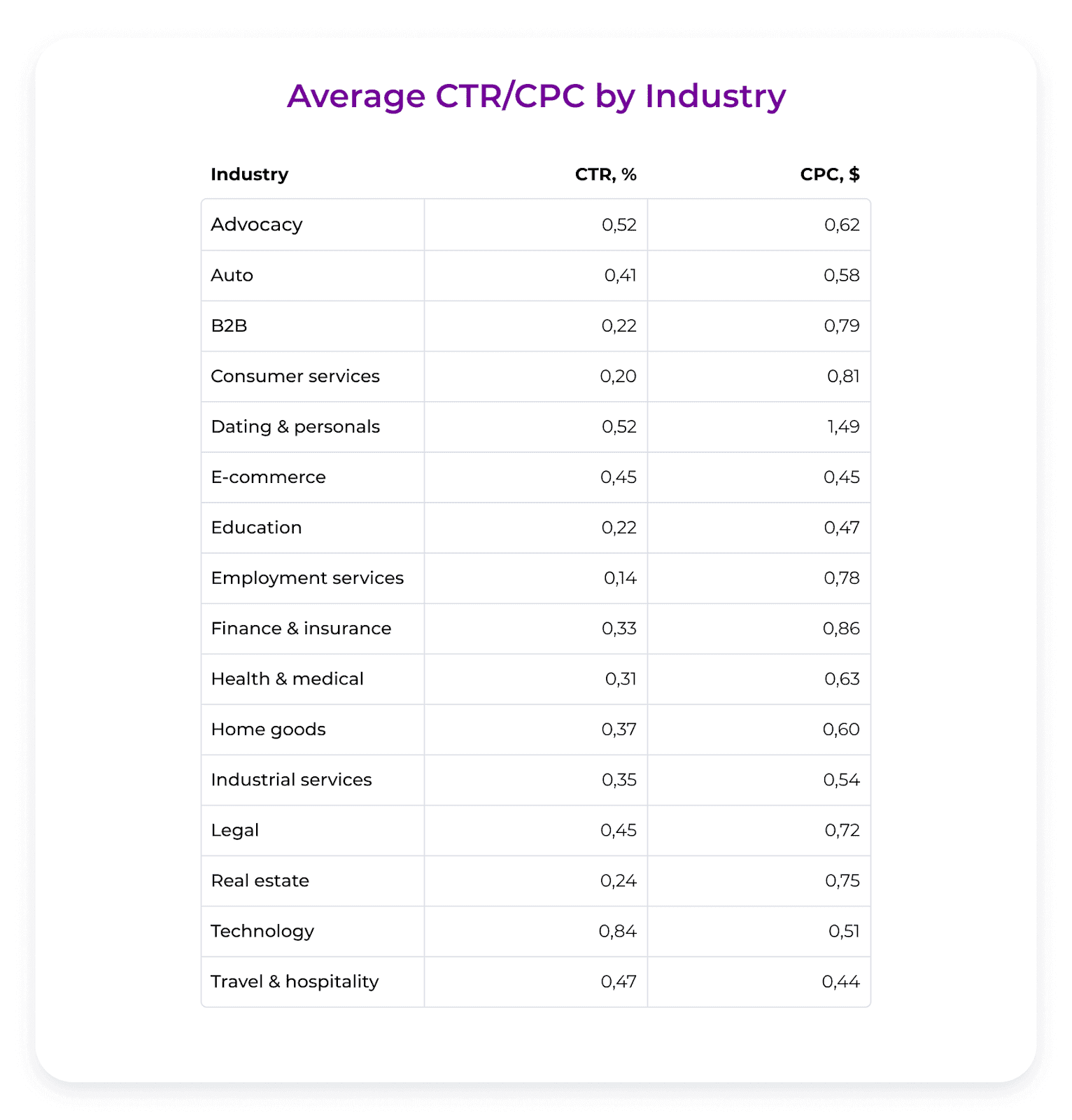
We can see that such online advertising industries as finance, real estate, B2B, insurance, dating & personals, as well as customer services, are the most expensive, while making money on travel and hospitality could become a real quest. Please also note that technology has the highest CTR of 0,84%, while the employment services industry is barely making it past 0,1%.
Step 3. Consider your CTR and page views per month. Once you’ve got your industry benchmarks, it is time to add up some more of your website metrics to the equation. Depending on the number of people who see your ads and click on them, your profits can vary greatly. Take a look at the tables below to compare how CTR and page visits can affect your earnings (data is taken from Taboola).
Pt.1
| Monthly page views | CTR% | Clicks | CPC ($) | Earnings ($) |
| 50.0000 | 0.05 | 25 | 0.58 | 14.5 |
| 100.000 | 0.05 | 50 | 0.58 | 29 |
| 200.000 | 0.05 | 100 | 0.58 | 58 |
| 300.000 | 0.05 | 150 | 0.58 | 87 |
| 400.000 | 0.05 | 200 | 0.58 | 116 |
| 500.000 | 0.05 | 250 | 0.58 | 145 |
| 600.000 | 0.05 | 300 | 0.58 | 174 |
| 700.000 | 0.05 | 350 | 0.58 | 203 |
| 800.000 | 0.05 | 400 | 0.58 | 232 |
| 900.000 | 0.05 | 450 | 0.58 | 261 |
| 1.000.000 | 0.05 | 500 | 0.58 | 290 |
Pt.2
| Monthly page views | CTR% | Clicks | CPC ($) | Earnings ($) |
| 50.0000 | 0.44 | 220 | 0.58 | 127.6 |
| 100.000 | 0.44 | 440 | 0.58 | 255.2 |
| 200.000 | 0.44 | 880 | 0.58 | 510.4 |
| 300.000 | 0.44 | 1.320 | 0.58 | 765.6 |
| 400.000 | 0.44 | 1.760 | 0.58 | 1020.8 |
| 500.000 | 0.44 | 2.200 | 0.58 | 1276 |
| 600.000 | 0.44 | 2.640 | 0.58 | 1531.2 |
| 700.000 | 0.44 | 3.080 | 0.58 | 1786.4 |
| 800.000 | 0.44 | 3.520 | 0.58 | 2041.6 |
| 900.000 | 0.44 | 3.960 | 0.58 | 2296.8 |
| 1.000.000 | 0.44 | 4.400 | 0.58 | 2552 |
From these tables, one can observe that a website with 50,000 page views per month, $0.58 average cost per click, and 0,05% CTR will generate 25 clicks and result in 14,5$ from one ad placement monthly. If we increase the CTR to 0,44% we will get an almost 10 times increase — 220 clicks and $127,6 per month. Finally, increasing the number of page views will improve the situation, even more, resulting in $2552 monthly earnings from one ad placement.
When it comes to Facebook ads, the average ad cost per download (cost per action) reaches up to $5,47. Plus, it was revealed that typical small businesses spend about $10,000 per month on online advertising campaigns. With this, web advertisement rates on Facebook grow like on every other platform, so it’s worth checking the rates regularly.
Step 4. Get to know your audience. When it comes to page views and traffic in general, it is always important to consider your audience and its value to the advertiser. The more precise data you have, the more you are going to get. Data from popular online advertising platforms like Google Ads or Facebook Ads might also serve you as benchmarks. Take a look at your traffic geography and try to align it with these average rates by country. You can notice that some countries give more expensive traffic than others due to higher purchase intents and levels of income, as well as bots and ad fraudsters.
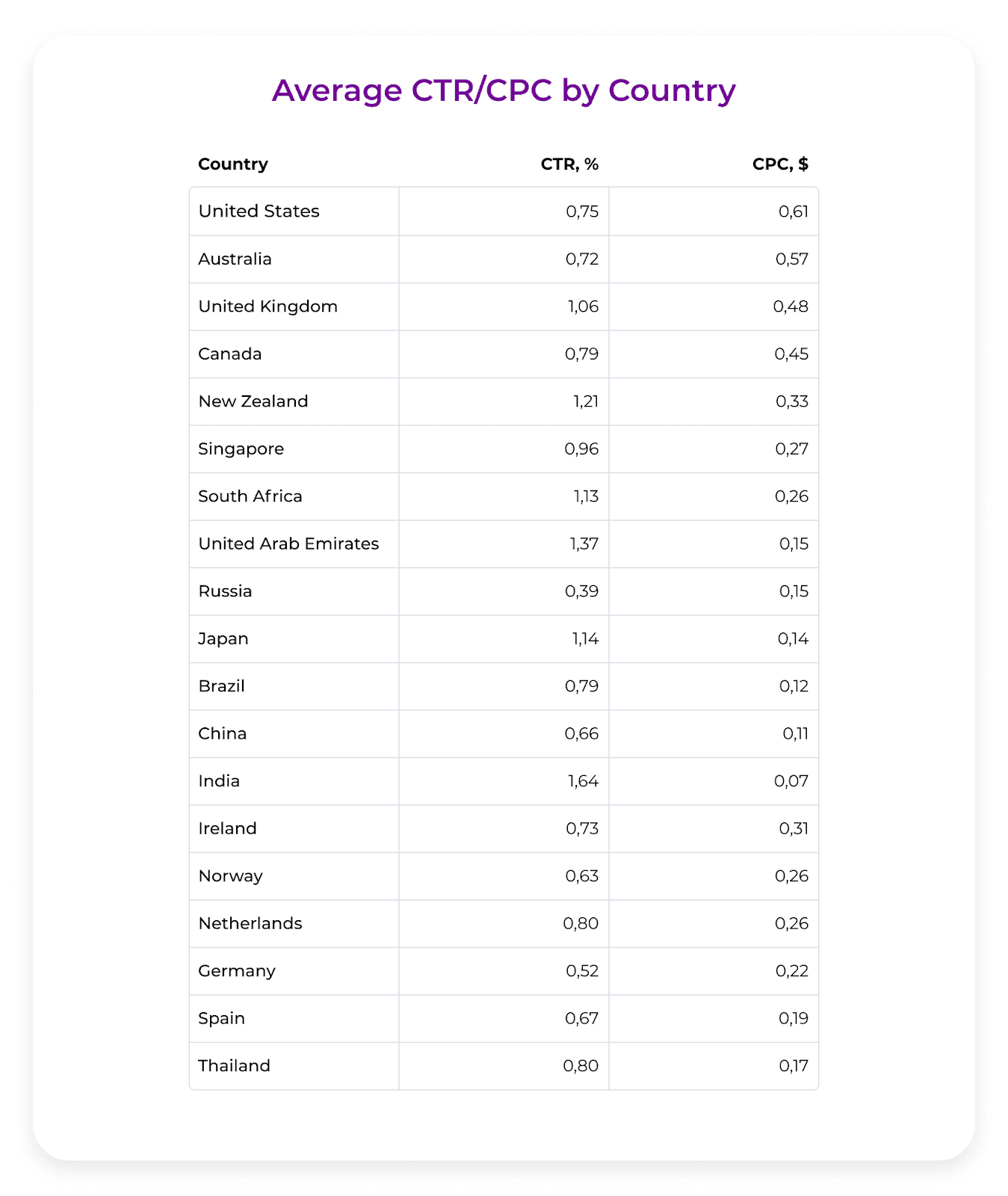
Countries with the highest spending potential and English as a first language are also getting the highest CPC, over $0,3 for New Zealand and $0,61 for the United States. Nevertheless, the highest click-through rates are observed in Japan, the United Arab Emirates, and India, so both metrics are important for the calculation of the total website advertising prices.
Step 5. Testing. Once you compare the given metrics and apply them to your own website’s performance, you need to understand where this is all heading. Having benchmarks will help you better understand your approximate online advertisement rate, but in order to get precise numbers, we recommend making a test. Start with an average, based on the aforementioned factors, and move in the necessary direction until you find your ‘golden middle’.
Step 6. Putting it all together. As a result of this comprehensive analysis, you should now have some vision regarding your ad prices for each slot per month, per day, or even per year. You should also have an understanding of your web pages’ fill rates. Now that you sum all of your ad placements’ prices and take into consideration their fill rates you should eventually come up with the monthly income generated by display ads online. Of course, this number can vary depending on additional factors like seasonality or local events, but at least now you have your online advertisement rate and, what is more important, you fundamentally understand where it comes from.
Side note: In reality, each publisher has their own way of calculating website banner advertising or rates for other formats. Some prefer to focus on different metrics and their combinations, while others simply divide monthly viewers by 10 and charge advertisers monthly with this price... In this post, we tried to examine the most influential factors that influence website advertising prices and align them with industry and geographical averages to help you get a more or less realistic first outlook.
Eventually, you can always come up with your own method or formula that would perfectly fit your website’s and business specifics. But we hope that this article helped you to get some understanding so that you could gear a successful online advertising monetization strategy.
Summary
Take a close look at your website metrics and how your niche performs on ads. This will help you understand the potential earnings and online advertising costs for your site. Once you have enough monthly visits, joining a supply-side platform lets you connect with global advertisers. They’ll compete for ad placements on your site through real-time bidding. From there, you can try out different ad sizes, formats, and pricing models, using real-time analytics to see what works best for you.
Sign up at SmartyAds SSP and get the real value for your ad inventory!
FAQ
Traffic volume alone isn’t enough; engagement and quality matter just as much. Advertisers value visitors who interact and convert, not just raw numbers. Tracking metrics like page views, CTR, and time on site helps determine if your audience is valuable.
Testing multiple models like CPM, CPC, or CPA lets you find the optimal balance of revenue and engagement. Different audiences respond better to different formats. Experimenting helps maximize profits without overcharging or underutilizing ad space.
Premium niches like finance, real estate, or tech command higher rates due to advertiser demand. Broad-interest topics may have more traffic but lower CPMs. Matching your content to high-value audiences ensures you capture higher ad bids.
Optimize your “hot spots” by placing ads where users naturally interact most. Combine strong content, mobile optimization, and appealing design to enhance viewability. Higher ad visibility and engagement lead to better pricing opportunities.

